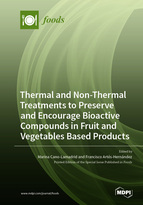Thermal and Non-Thermal Treatments to Preserve and Encourage Bioactive Compounds in Fruit and Vegetables Based Products
A special issue of Foods (ISSN 2304-8158). This special issue belongs to the section "Food Engineering and Technology".
Deadline for manuscript submissions: closed (15 November 2021) | Viewed by 53344
Special Issue Editors
Interests: food analysis; food processing; antioxidants; food technology; food safety; food quality
Special Issues, Collections and Topics in MDPI journals
Interests: fruit & vegetables; postharvest; fresh-cut; minimal processing; by-products revalorization, green processing technologies; quality & safety; abiotic stress, bioactive compounds; phytochemicals, nutraceuticals, shelf life
Special Issues, Collections and Topics in MDPI journals
Special Issue Information
Dear Colleagues,
Fruit- and vegetable-based products (F&V products) can be preserved through thermal processing (pasteurization, scalding, and drying), ensuring microbial safety and/or enzyme deactivation. However, apart from being the most cost‐effective tools, thermal treatments could also reduce bioactive compounds, nutrients, and even organoleptic properties. Nowadays, non-thermal food processing technologies (e.g., UV light and high-pressure processing) have been widely studied for developing food products with and extended shelf life, preserved bioactive compounds, and improved organoleptic properties.
Key findings and conclusions:
This Special Issue focuses on the effect of thermal and non-thermal treatments on shelf-life, key bioactive compounds changes (flavonoids and non-flavonoids), enzymatic antioxidant systems, and non-enzymatic antioxidant systems of fruit- and vegetable-based products.
Dr. Marina Cano-Lamadrid
Prof. Dr. Francisco Artés-Hernández
Guest Editors
Manuscript Submission Information
Manuscripts should be submitted online at www.mdpi.com by registering and logging in to this website. Once you are registered, click here to go to the submission form. Manuscripts can be submitted until the deadline. All submissions that pass pre-check are peer-reviewed. Accepted papers will be published continuously in the journal (as soon as accepted) and will be listed together on the special issue website. Research articles, review articles as well as short communications are invited. For planned papers, a title and short abstract (about 100 words) can be sent to the Editorial Office for announcement on this website.
Submitted manuscripts should not have been published previously, nor be under consideration for publication elsewhere (except conference proceedings papers). All manuscripts are thoroughly refereed through a single-blind peer-review process. A guide for authors and other relevant information for submission of manuscripts is available on the Instructions for Authors page. Foods is an international peer-reviewed open access semimonthly journal published by MDPI.
Please visit the Instructions for Authors page before submitting a manuscript. The Article Processing Charge (APC) for publication in this open access journal is 2900 CHF (Swiss Francs). Submitted papers should be well formatted and use good English. Authors may use MDPI's English editing service prior to publication or during author revisions.
Keywords
- Bioactive compounds
- Nutraceuticals
- Antioxidants
- By-product revalorization
- Light stresses (UV-B & C; LEDs; pulses)
- High Hydrostatic Pressure (HPP)
- Microwave and Radiofrequency
- Pulse electric fields
- Oscillating magnetic fields
- Cold plasma
- Ultrasound
- Drying








